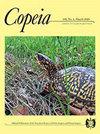No Sperm Morphometric Differences between Two Populations of Diamond-backed Watersnakes (Nerodia rhombifer) with Varying Resource Availability
IF 2.6
Q2 Agricultural and Biological Sciences
引用次数: 0
Abstract
Vast differences in available resources between habitats can have profound influences on aspects of an organism's life history, such as reproductive investment. Our study investigated how differences in nutrient availability affect sperm size in Diamond-backed Watersnakes (Nerodia rhombifer). We compared body size and sperm morphometrics between two populations with differing nutrient availability: a naturally occurring lake and a commercial fish farm. We hypothesized that prey availability affects sperm morphometrics. Our null hypothesis was that there would be no significant difference in sperm morphometrics between populations, whereas our alternative hypothesis was that the snakes from the fish farm would have significantly longer sperm. We measured total sperm length, sperm head length, sperm tail length, and snout–vent length (SVL). We then used two-tailed t-tests and AIC model selection to test our hypotheses. SVL was not correlated with sperm size. Furthermore, none of the sperm morphometrics were significantly different between the two populations. Finally, a nearly 1:1 correlation between sperm tail length and total sperm length was found. AIC model selection corroborated these results by choosing only sperm head length and sperm tail length as significant predictors of total sperm length. This is the first published study to explicitly compare sperm morphometrics between two populations of the same snake species. Additional studies of this nature are required to corroborate whether lack of significant differences in sperm morphometrics among snake populations are common.不同资源可得性下菱形背水蛇两种群精子形态的差异
栖息地之间可用资源的巨大差异可能会对生物体生命史的各个方面产生深远影响,例如生殖投资。我们的研究调查了营养有效性的差异如何影响钻石背水蛇(Nerodia rhombifer)的精子大小。我们比较了两个营养供应不同的种群的体型和精子形态指标:一个是天然湖泊,另一个是商业渔场。我们假设猎物的可利用性会影响精子的形态计量学。我们的无效假设是,种群之间的精子形态计量学没有显著差异,而我们的替代假设是,养鱼场的蛇精子会明显更长。我们测量了精子总长度、精子头部长度、精子尾部长度和口鼻部长度(SVL)。然后,我们使用双尾t检验和AIC模型选择来检验我们的假设。SVL与精子大小无关。此外,两个群体的精子形态计量学没有显著差异。最后,发现精子尾部长度与精子总长度之间存在近似1:1的相关性。AIC模型选择证实了这些结果,只选择精子头部长度和精子尾部长度作为总精子长度的重要预测因素。这是第一项明确比较同一蛇种两个种群精子形态计量学的已发表研究。这种性质的额外研究需要证实蛇种群之间精子形态计量学缺乏显著差异是否常见。
本文章由计算机程序翻译,如有差异,请以英文原文为准。
求助全文
约1分钟内获得全文
求助全文
来源期刊

Copeia
生物-动物学
CiteScore
2.10
自引率
0.00%
发文量
0
审稿时长
6-12 weeks
期刊介绍:
Founded in 1913, Copeia is a highly respected international journal dedicated to the publication of high quality, original research papers on the behavior, conservation, ecology, genetics, morphology, evolution, physiology, systematics and taxonomy of extant and extinct fishes, amphibians, and reptiles. Copeia is published electronically and is available through BioOne. Articles are published online first, and print issues appear four times per year. In addition to research articles, Copeia publishes invited review papers, book reviews, and compiles virtual issues on topics of interest drawn from papers previously published in the journal.
 求助内容:
求助内容: 应助结果提醒方式:
应助结果提醒方式:


